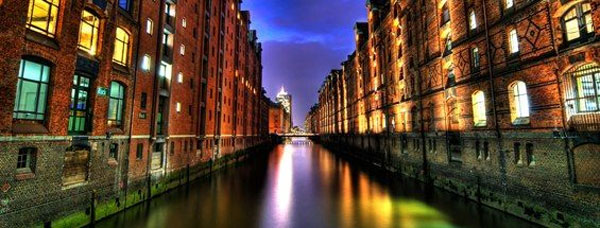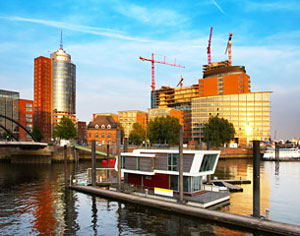Reply To:
Name - Reply Comment

Despite its location - 109 km inland on the River Elbe – Hamburg is one of the largest sea ports in Europe. The deep River Elbe allows large ocean vessels to reach the inland harbour, and has ensured Hamburg’s wealthy mercantile status throughout the ages.
Hamburg has more canal bridges (2,300 at the last count) than Amsterdam, plus lakes and city parks. In fact, the city-state is said to be the most verdant in Europe with more than half of its area given over to water, woodlands, farmland, and 1,400 parks and gardens. This city –the second largest in Germany – is green in more ways than one, and has a healthy cycling population.
Since being founded 12 centuries ago, Hamburg has been destroyed numerous times. In 845 a fleet of Viking ships sailed up the River Elbe, and destroyed the fledgling town. Two centuries later it was burned down by an enraged Polish King, before being raided and occupied (twice) at the beginning of the 13th century. Two Great Fires – one in 1284 and the other in 1842 – wiped out much of the inner city, and finally the city and its harbour were razed to the ground during WW2.
However, the Hamburgers (pronounce it ‘humbourger’ and you’ll find it doesn’t feel so ridiculous) are an industrious lot and out of the rubble a larger and more beautiful city has emerged. Today, the city’s 1.8 million residents count abundant greenery, impressive architecture and four million annual visitors amongst their many blessings.
 Attractions
Attractions
Before you start your city tour, orient yourself from the tower of Germany’s finest Baroque church, Hauptkirche St. Michaelis. Known to the locals as ‘Michel’, the church’s crypt is the final resting place of the composer Bach, while the hammered-copper tower affords a sweeping view of the cityscape and harbour. The ascent requires a challenging 449 spiral steps, but you can opt to take the lift if you prefer.
Hamburg has more than just canals in common with Amsterdam: its most famous thoroughfare is the Reeperbahn, an entertainment and red light district. The eclectic mix of bars, restaurants and theatres make it a worthwhile tourist destination, but those of a more sensitive disposition will not appreciate the abundant sex shops, erotic museums, strip clubs and crowds.
A less discordant destination is the historical warehouse district of Speicherstadt. Adjacent to the harbour, the largest warehouse complex in the world features narrow cobbled streets and waterways. These are lined by 100-year old warehouses which store cocoa, silk, and oriental carpets. Light projections in the evening create a magical atmosphere as they dance across the buildings, bridges and canals.
Also recommended is a trip to the St Pauli Landungsbrücken. Landing bridges which are part of Hamburg Harbour, they sit adjacent to the Fish Market and are a major tourist attraction. Many of the enjoyable harbour and canal tours originate from here.
Dining and Nightlife
Hamburg may have donated its name to the American fast-food favourite, but don’t expect to find the city’s restaurant menus lined with hamburgers: they are not a popular dish. The closest you’ll get is a traditional frikadelle – a pan-fried patty made from a mixture of ground beef, soaked bread, egg, chopped onion, salt and pepper. It’s usually served with potatoes and vegetables like any other piece of meat.
As a maritime city, Hamburg has a superb seafood reputation and diners can enjoy freshly caught produce at the many Fish Market taverns: lobster from Helgoland; shrimp from Büsum; turbot, plaice, and sole from the North Sea; and huge quantities of fresh oysters.
If you don’t want to brave the nightlife of the Reeperbahn, visit the creative neighbourhood of Schanzenviertel with its charming Portuguese, Turkish and Asian street cafés and vibrant bars.
Beyond Hamburg
For a weekend getaway from Hamburg, join the hordes of German celebrities who flock to the North Sea island of Sylt for a break from the city. Connected to the German mainland by a causeway, the island can be reached by train and is famous for its healthy climate and bracing sea air. Its 40km of sandy beach is lined with unspoilt dunes, green dykes, flowering heaths and jagged cliffs, a backdrop which makes for a peaceful, secluded visit.
Emirates operates daily flights to Hamburg from Dubai using a state-of-the-art fleet including the Boeing 777-300ER. Discover Emirates luxurious inflight offerings on Hamburg flights, which include private suites in First Class, lie-flat seats in Business Class and a new generation of comfort in Economy Class. All classes feature ice, Emirates onboard information, communication and entertainment system offering up to 1,400 channels, ensuring pleasant flights to Hamburg.